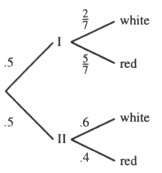Solve the problem.Urn I contains two white balls and five red balls; urn II contains six white balls and four red balls. An urn is chosen at random and then a ball is chosen from that urn.(a) Draw a tree diagram for this two-stage experiment, and label it with the appropriate probabilities.(b) What is the probability that the chosen ball is white?(c) What is the probability that the chosen ball came from urn I, if it is white?
What will be an ideal response?
(a)

| (b) |  |

You might also like to view...
Use a calculator to find the function value. Give your answer rounded to seven decimal places, if necessary.sin (-34°20')
A. -0.5640066 B. -0.5620834 C. -0.5562956 D. -0.5543603
Perform the division and write the answer without using negative exponents.
?

What will be an ideal response?
Solve the problem.A biologist collected 277 fern and moss samples. There were 13 fewer ferns than moss samples. How many fern samples did the biologist collect?
A. 145 fern samples B. 79 fern samples C. 264 fern samples D. 132 fern samples
Translate the following into an equation where x represents the unknown number. Then solve the equation for x. is the product of a number and -
is the product of a number and -  .
.
A.  x = -
x = -  , x = - 1
, x = - 1
B.  = -
= -  x, x =
x, x = 
C.  = -
= -  x, x = -
x, x = - 
D.  x = -
x = -  , x = -
, x = - 